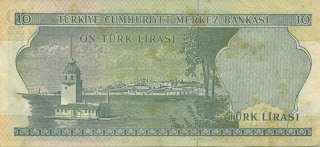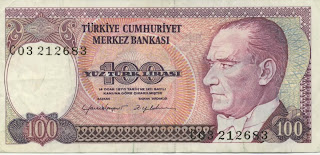The Republic of Turkey is a country that strides both Europe and Asia. It's capital city is Ankara. From the early 19th century the Ottoman Empire was in decline and by the end of World War I the Ottoman empire was on the loosing side and the allies partitioned off the various parts. In 1922 , the Turkish regime had expelled all foreign troops and established modern day Turkey under the secular presidency of Mustafa Kemal - to whom they gave the title Ataturk (father of the Turks). Turkey joined NATO in 1952. Turkey invaded Cyprus in 1974 and nine years later they recognised the Turkish Republic of North Cyprus - no other country recognises North Cyprus. In 1984 the PKK , a Kurdish separatist group started an insurgency campaign to recognise the right to be Kurdish.
Monetary Unit:
1 Lira = 100 piastres
The first of our notes, above, are the 10 and 5 Lira notes from 1930 in the Rumi calendar or 1966 in the western calendar. Both notes have Ataturk on the front but the 10 Lira note has Maidens tower on the reverse while the 5 Lira note has the Manavgat waterfalls on it reverse.
100,000 Lira is from 1991 and has quite a creepy portrait of Ataturk on the front and Children presenting flowers to Ataturk on the reverse.
20,000 Lira from 1988 with Ataturk on the front and the central bank building on the reverse.
10,000 Lira from 1989 this time the reverse has the Selimiye mosque with Mimar Sinan the architect
5,000 Lira from 1990 with the Afsin-elbistan power station on the reverse.
1000 Lira from 1986 with the Istanbul coastline in the background and Fathi Sultan Mehmat on the reverse.
100 Lira from 1984 with the fort at Ankara, Mehmet Akif Ersoy with his house and a copy of his Istiklal Marsi - the Turkish National Anthem.
The 1, 5, and 10 thousand Lira notes also have dots for the visually impaired on them.
These are some of the first notes I collected. I was given around 30 of these Turkish notes, most in really bad condition along with an equal amount of Yugoslavian note too.
















No comments:
Post a Comment